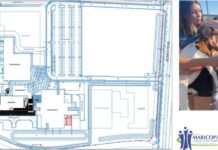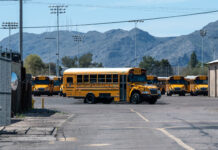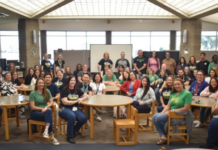The following letter was sent to lawmakers by members of the Arizona School Board, including Torri Anderson, member of the Maricopa Unified School District Board:
Honorable Governor Doug Ducey, Superintendent Kathy Hoffman, and Esteemed Legislators,
As Governing Board members across the state of Arizona, we have been elected to serve, educate, and protect the children in our communities.
The Arizona Department of Health Services indicates there were 3,653 new cases of COVID-19 reported today. There are over 105,000 positive cases in Arizona right now and there have been almost 2000 deaths related to this virus so far.
Positive cases in Arizona are trending upward, not downward. We cannot reopen our schools for on-site learning until we experience a downward trajectory of documented cases within a 14-day period. We want to help mitigate the spread of the COVID-19 virus, not contribute to higher and higher numbers of outbreaks and deaths in our communities. With this, we ask for the following:
* Statewide closure of buildings and classrooms until October 1st, or the date on district academic calendars that marks the end of the first quarter of instruction.
* In October, districts may consider reopening buildings and classrooms for in-person learning when we meet agreed-upon levels of COVID-19 data points that show a reduction of risk and infection in our communities.
* In October, districts may reopen buildings and classrooms when we meet agreed-upon safety protocols and requirements, as determined by the Center for Disease Control and the Arizona Department of Health.
* Fund distance learning at the same level as in-person instruction without the requirement to also provide face-to-face classes five days a week.
* Provide clarity and assurance that every school receive 100% of their prior year funding through the Enrollment Stability Grant, despite the COVID-19 specific related expenses we may incur.
* Waive the 180 instructional day requirement for the school year 2020-2021.
* Suspend the statewide standardized assessment, AzM2, for school year 2020-2021 and allow districts to use local assessments to track academic progress for accountability purposes.
* Ask the Arizona Department of Education to submit an extension or new waiver for the USDA school lunch program so schools can offer ‘to-go’ meals to students even when campuses are closed.
When Governor Ducey announced schools could not open for on-site learning until August 17, 2020, he said this was an ‘aspirational goal.’ We need real goals and plans so we can focus on instructional, facility and transportation planning. Let administrators and teachers plan for and excel at teaching the first quarter remotely. If there is a reduction of risk and infection in our communities, this natural break in our academic calendar will be an ideal time to consider returning to in-person learning.
We thank you for allocating more funding for this crisis. We need time and resources to bring our buildings to the standards outlined by the Center for Disease Control. Every community in Arizona deserves this level of safety and precaution before students and employees can be allowed to return to in-person learning. We ask for flexibility in the 180 day school year calendar so we return to our campuses and classrooms when they are safe and not because we are calculating how many school days each student must complete. Let’s come together and agree on what safety standards will be, the funding that it will take to get there, and the timing we’ll need to reach this life-saving expectation.
We also ask for suspension of statewide standardized testing. Let us hold ourselves accountable with our local assessments and data points. The recommendations from the CDC for students to all face the same direction, spaced apart in rows allowing for six feet or more distance between each desk is the opposite of what we know works for collaborative, hands-on, inquisitive learning. How can our teachers maintain or improve learning, as measured by AzMerit 2, in an environment that discourages interaction and engagement? We ask that our focus this academic year be offering high-quality remote-learning and a measured return to safe in-person classes, rather than on reaching higher levels of academic success as measured by a single assessment.
Remote learning is the only guarantee we have for the safety of our students and staff during the rising COVID-19 outbreak in our state. The latest executive order, as presented, penalizes school districts for offering only remote learning, as it requires districts to offer a physical attendance option for five days a week to receive 100% funding for remote on-line instruction through the order’s budget stabilization process. No study indicates that the number of infections will have decreased by any certain day on the calendar, and administrators, teachers, and families across the state are very nervous about returning to our school buildings and classrooms. The decision to offer face-to-face classes should be made with medical data which shows a decreasing trend in COVID -19 cases, not as an overarching requirement that financially forces teachers and staff to socially interact with students six hours at a time, every day of the week.
While we appreciate the decision to require five days of on-site learning is to assure families have a place to send their children so they can continue to earn an income and financially contribute to our economy, this decision is inequitable and greatly impacts our poorest communities the most. The majority of families in our wealthiest neighborhoods will be able to work from home and continue to deliver on-line classes to their children remotely. Working-class families do not have this luxury, and the schools in our poorest communities will see the largest class sizes, and undoubtedly a larger number of COVID-19 infections and fatalities.
We thank you for recognizing the importance of stabilizing our district budgets with Enrollment Stability Grants. While competition to increase enrollment has become a central focus of every public district and charter system in our state, this is not the year to focus on recruitment and retention of students. Instead, we must focus on their health and well-being during this COVID-19 crisis. We can do this by bringing stability to school district budgets. We should not be competing right now for enrollment numbers. Instead, we should be working together to keep students learning in the safest environment possible.
We must work together, align with city, county and higher education partners to find other ways to keep ALL of our families earning, yet safe and learning as COVID-19 infections continue to reach greater and greater numbers. This is the only way we fight back and reverse the trend of infections and deaths in our state. We thank you for working with us to serve and protect our communities and Arizona families at this unprecedented time.
Arizona School Board Members,
Kristel Ann Foster, Tucson Unified School District
Stanford Prescott, Phoenix Union High School District
Adam Lopez Falk, Alhambra Elementary School District
Lindsay Love, Chandler Unified School District
Steven Chapman, Tolleson Union High School District
Devin Del Palacio, Tolleson Union High School District
Jeanne Casteen, Creighton Elementary School District
Monica Timberlake, Quartzsite Elementary School District
Nicci Collier, Quartzsite Elementary School District
Nikkie Whaley, Washington Elementary School District
Kara Kelty, Flagstaff Unified School District
Xochitl Valdez, Alhambra Elementary School District
Adelita Grijalva, Tucson Unified School District
Mariana Sandoval, Agua Fria Union High School District
Jete White, Pendergast Elementary School District
Channel Powe, Balsz Elementary School District
Martín J. Quezada, Pendergast Elementary School District
Aaron Jahneke, Washington Elementary School District
Richard Adler, Humboldt Unified School District
Kevin Opalka, Sahuarita Unified School District
Buck Crouch, Sunnyside Unified School District
Maria L. Neuman, Santa Cruz Valley Unified School District
Ryan Gray, Humboldt Unified School District
John E. Hays, Santa Cruz Valley Unified School District
John Sparks, Sahuarita Unified School District
Berdetta Hodge, Tempe Union High School District
Monica Trejo, Tempe Elementary School District
Annette Sexton-Ruiz, Creighton Elementary School District
Matthew Kopec, Amphitheater Unified School District
Monica Gallardo Pimentel, Glendale Elementary School District
Patrick Morales, Tempe Elementary School District
Carmen Trujillo, Phoenix Elementary Union District
Marissa E. Hernandez, Cartwright Elementary School
Eva Carrillo Dong, Sunnyside Unified School District
Denice Martha Garcia, Cartwright Elementary School District
Mary Kay Utecht, Agua Fria Union High School District
David Sandoval, Peoria Unified School District
Ylenia Aguilar, Osborn Elementary School District
Torri Anderson, Maricopa Unified School District
Stephen M Oesterle, Continental Elementary School District
Monica Ceja Martinez, Peoria Unified School District












![Alleged car thief released without charges Phoenix police stop a stolen vehicle on April 20, 2024. [Facebook]](https://www.inmaricopa.com/wp-content/uploads/2024/04/IMG_5040-218x150.jpg)

![3 things to know about the new city budget Vice Mayor Amber Liermann and Councilmember Eric Goettl review parts of the city's 2024 operational budget with Mayor Nancy Smith on April 24, 2024. [Monica D. Spencer]](https://www.inmaricopa.com/wp-content/uploads/2024/04/spencer-042424-preliminary-budget-meeting-web-100x70.jpg)


